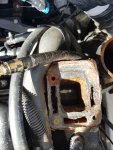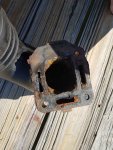TBarCYa
Senior Chief Petty Officer
- Joined
- Apr 13, 2005
- Messages
- 781
So now I'm totally stumped. I checked and I have spark at the plugs. It's not amazing, but there is spark. I replaced the cap, rotot, plugs, wires and coil. I did not replace the ignition module or the pickup coil but the coil tested good. I have 12.6v feeding the coil and at the distributor. I cleaned all of the battery connections. I even bypassed the neutral switch.
When I pour fuel in the carb, it doesn't even try to start until it works that through, then it tries to fire. So I'm flooding it with dumping fuel in. That leads me to believe that my carburetor is working as expected. I get the same result if I pump the throttle several times before cranking.
So thinking logically, an engine needs air, fuel, spark and compression to run... And timing. I haven't tested the compression yet because the engine was running on Saturday before the backfire / etc. The distributor hasn't moved because I tried to move it and cannot. The question then is the timing chain. I don't hear any weird noises from the engine when cranking but is it possible that the timing chain jumped a tooth? I know the cam is turning because the distributor is turning.
I hate to have to take it to a shop but that's where this is leading if I don't make some progress soon.
When I pour fuel in the carb, it doesn't even try to start until it works that through, then it tries to fire. So I'm flooding it with dumping fuel in. That leads me to believe that my carburetor is working as expected. I get the same result if I pump the throttle several times before cranking.
So thinking logically, an engine needs air, fuel, spark and compression to run... And timing. I haven't tested the compression yet because the engine was running on Saturday before the backfire / etc. The distributor hasn't moved because I tried to move it and cannot. The question then is the timing chain. I don't hear any weird noises from the engine when cranking but is it possible that the timing chain jumped a tooth? I know the cam is turning because the distributor is turning.
I hate to have to take it to a shop but that's where this is leading if I don't make some progress soon.





















